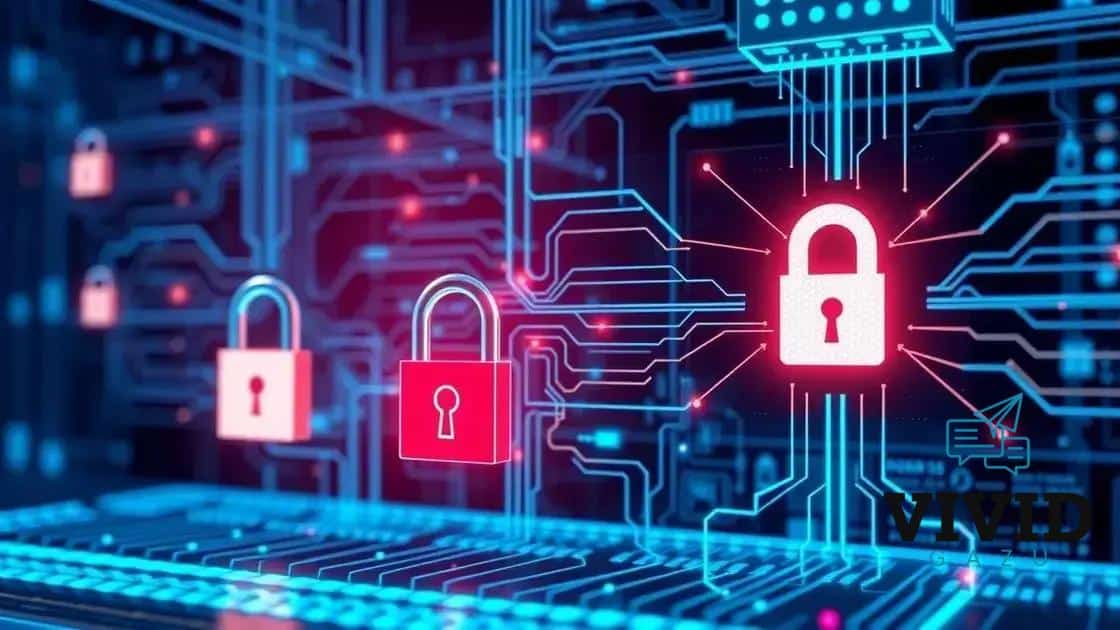Post-quantum security becomes enterprise priority

Post-quantum security involves implementing cryptographic methods designed to protect data from future quantum computing threats, ensuring organizations maintain data integrity and safeguard sensitive information.
Post-quantum security becomes enterprise priority as the digital landscape evolves. But what does this mean for businesses today?
Understanding post-quantum security
Understanding post-quantum security is essential as we prepare for the future of cybersecurity. This new approach aims to protect data from the potential threats posed by quantum computers. As quantum technology advances, traditional encryption methods may become vulnerable, necessitating a shift in how we secure sensitive information.
What is Post-Quantum Security?
Post-quantum security refers to the development of cryptographic systems that are secure against an adversary equipped with quantum computers. These systems must be designed to withstand algorithms like Shor’s algorithm, which could easily break current encryption standards.
Key Features of Post-Quantum Cryptography
- Resistance to Quantum Attacks: Algorithms must be developed to ensure they cannot be easily exploited by powerful quantum machines.
- Diverse Cryptographic Techniques: Multiple approaches, including lattice-based and hash-based cryptography, are being explored.
- Transition Strategies: Businesses need clear plans to move from classical to post-quantum solutions without disrupting operations.
As organizations start to implement post-quantum security, they will face several challenges. For instance, integrating new technologies with existing systems can be complicated. Additionally, the need for both hardware and software updates may require significant investment.
Education about post-quantum security is crucial. Businesses must train their teams on how these new systems work and the importance of safeguarding data against future threats. Without this knowledge, there is a higher risk of falling behind in the security landscape.
In addition, staying informed about the latest developments in quantum computing will help organizations prepare better for evolving security needs. As potential threats increase, understanding post-quantum security becomes not just a recommendation, but a necessity.
Impact of quantum computing on cybersecurity

The impact of quantum computing on cybersecurity is profound and requires urgent attention. As quantum computers become more capable, they threaten traditional encryption methods. Understanding these impacts is crucial for organizations aiming to protect their data.
Threats to Current Encryption
Current cryptographic algorithms, such as RSA and ECC, rely on the difficulty of certain mathematical problems. Quantum computers can solve these problems much faster than classical computers. This means that sensitive data, such as financial information and personal records, could be at risk.
Potential Vulnerabilities
- Decryption of Sensitive Data: Quantum computers could decrypt securely stored data with ease.
- Identity Theft Risks: As encryption standards weaken, the chance of identity theft increases.
- Data Manipulation: Attackers could manipulate data in transit without detection.
Organizations must recognize that the shift to quantum computing isn’t just a future issue; it is an ongoing reality. Transitioning to quantum-resistant algorithms is essential. As the landscape evolves, traditional systems may become obsolete, leaving businesses vulnerable.
Collaboration between cybersecurity professionals and quantum researchers is vital to address these challenges. By understanding the implications of quantum computing, organizations can develop better strategies to protect their data.
Staying informed about advancements in quantum technology is key. As threats emerge, adapting to these changes will help organizations remain secure against evolving cyber risks.
Key strategies for enterprises
Implementing key strategies for enterprises is vital in the age of post-quantum security. As organizations face new challenges from quantum computing, it is essential to adapt and secure their systems.
Developing a Roadmap
Your enterprise should begin with a clear roadmap to transition to quantum-resistant cryptography. This includes evaluating current systems and understanding potential vulnerabilities. A proactive approach will help identify which areas require immediate improvement.
Employee Training and Awareness
Investing in employee training is crucial. By educating teams on quantum security, organizations can foster a culture of vigilance. Regular workshops and updates on emerging threats will keep everyone informed and prepared.
- Skill Development: Train employees on new technologies and security practices.
- Awareness Programs: Conduct sessions to understand the impacts of quantum computing.
- Simulated Attacks: Use drills to prepare staff for potential security breaches.
Adapting existing security protocols is another essential strategy. Businesses must collaborate with cybersecurity experts to integrate new algorithms and frameworks that can withstand quantum attacks. This means regularly updating systems and ensuring that software is equipped with the latest security measures.
Additionally, forming partnerships with academic institutions and research organizations can provide insights into the latest advancements in post-quantum security. Engaging with experts will keep your enterprise on the cutting edge of security technology.
Finally, staying ahead of regulatory requirements is important. As governments adapt to the evolving landscape of cybersecurity threats, companies should align with emerging regulations regarding quantum security to ensure compliance and protect their interests.
Challenges in transitioning to post-quantum solutions

Transitioning to post-quantum solutions presents various challenges that enterprises must navigate carefully. As organizations recognize the urgency of adopting these technologies, understanding the hurdles ahead becomes essential.
Understanding Legacy Systems
One major challenge lies in the integration of new quantum-resistant cryptographic systems with existing legacy systems. Many organizations have deeply embedded systems that utilize traditional encryption methods. Adapting or replacing these systems can require significant resources, time, and planning.
Cost Implications
The costs associated with transitioning to post-quantum solutions can also be a barrier. From upgrading software to investing in training for staff, expenses can quickly add up. Organizations must strategically budget for these changes to ensure a smooth transition.
- Training Costs: Educating employees about new concepts and tools can be expensive but necessary.
- Infrastructure Updates: Enhancing hardware and software systems may require significant investment.
- Testing and Implementation: Thorough testing is crucial to ensure compatibility and security, which can increase labor costs.
Another challenge includes ensuring that all stakeholders are on board with the transition. Some team members may resist changes due to fear of the unknown or lack of understanding. Communicating the benefits of post-quantum security and providing adequate training can mitigate resistance.
The evolving nature of quantum threats also adds pressure. As technology continues to advance, organizations must stay informed about the latest developments and adjust their strategies accordingly. This requires ongoing vigilance and adaptability in security measures.
Furthermore, there is a need for collaboration among industry partners. Developing standard protocols for post-quantum security will be essential to ensure compatibility across different systems and organizations.
Future outlook for post-quantum security
The future outlook for post-quantum security is promising, yet challenging. As technology evolves, organizations must adapt to the increasing threats posed by quantum computing.
Emerging Trends in Security Solutions
Companies are beginning to recognize the importance of developing quantum-resistant cryptographic methods. Research in this area is expanding, leading to new algorithms designed to withstand quantum attacks. Investments in these solutions will be key for maintaining data integrity.
The Role of Collaboration
Collaboration among industry leaders, researchers, and government institutions will shape the landscape of post-quantum security. By working together, stakeholders can develop standardized protocols that ensure interoperability and robust security measures.
- Joint Research Initiatives: Collaborative projects can accelerate innovation in quantum security solutions.
- Community Forums and Conferences: Engaging in discussions at industry events will keep companies informed about best practices.
- Regulatory Frameworks: Governments are likely to create guidelines that promote the adoption of quantum-resistant technologies.
As organizations embrace post-quantum security, the focus will also shift toward integration. Businesses must ensure that new security measures fit seamlessly into their existing systems. This approach will minimize disruptions while maximizing protection against potential threats.
Additionally, educating the workforce about the significance of quantum security will be essential. Continuous training will empower employees to recognize vulnerabilities and take proactive steps toward securing sensitive information.
Finally, staying ahead of the curve means adopting a forward-thinking mindset. Organizations that prioritize post-quantum security will not only protect their data but also build trust with customers and stakeholders alike. Proactive measures will define the success of businesses in a quantum-enabled future.
FAQ – Frequently Asked Questions about Post-Quantum Security
What is post-quantum security?
Post-quantum security refers to cryptographic methods designed to be secure against the potential threats posed by quantum computing. It aims to protect data and systems from future attacks.
Why is post-quantum security important?
As quantum computers advance, they threaten to break traditional encryption methods. Post-quantum security is essential to safeguard sensitive information and maintain data integrity.
How can organizations prepare for post-quantum security?
Organizations can prepare by assessing their current encryption methods, investing in quantum-resistant technologies, and providing training to their staff on new security practices.
What challenges do companies face in adopting post-quantum solutions?
Challenges include integrating new systems with legacy software, managing costs associated with upgrades and training, and ensuring staff readiness for change. Additionally, staying compliant with evolving regulations is crucial.





